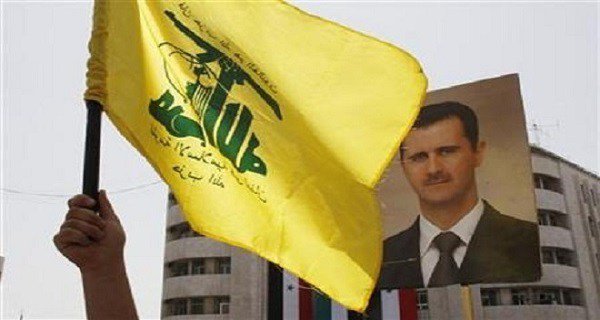جيروزاليم بوست: نظام الأسد يمنح المواطنة للمقاتلين من الإيرانيين وحزب الله
عربي 21 /الاثنين 26 تشرين الثاني 2018
نشرت صحيفة “جيروزاليم بوست” تقريرا، تقول فيه إن موقعا إسرائيليا كشف عن أن النظام السوري منح حق المواطنة لمقاتلي حزب الله والحرس الثوري الإيراني. ويورد التقرير، الذي ترجمته “عربي21″، نقلا عن معهد أبحاث الإعلام في الشرق الأوسط (ميمري)، قوله إن “الفعل المنظم من النظام لتوطينهم في سوريا” يخدم هدفين: الأول هو إخفاء وجود المقاتلين في البلد، والثاني تغيير طبيعة البلاد السكانية. وتقول الصحيفة إن إخفاء وجود المقاتلين في سوريا يعد خرقا للتفاهمات التي تمت بين روسيا وإسرائيل بشأن إبعاد هؤلاء المقاتلين عن حدود إسرائيل الشمالية. ويشير التقرير إلى أن موسكو قد وافقت في نهاية تشرين الأول/ أكتوبر على توسيع المنطقة العازلة في مرتفعات الجولان، لافتا إلى أن الروس رفضوا الطلب الإسرائيلي بأن تكون المسافة 40 كيلومترا، لكنهم عبروا عن استعداد لتوسيع المنطقة إلى مسافة تمتد ما بين 10-15 كيلومترا. وتلفت الصحيفة إلى أنه مع تراجع الحرب السورية لصالح نظام بشار الأسد، فإن هناك مخاوف من قيام إيران وحزب الله بتزويد المقاتلين بالصواريخ الدقيقة الموجهة، والدعم للجماعات الشيعية، التي أوجدت لها موطئ قدم في الجنوب السوري، مشيرة إلى أن إسرائيل عبرت عن قلقها من وجود الإيرانيين على حدودها، وتهريب الأسلحة المتقدمة من إيران إلى حزب الله عبر سوريا. ويجد التقرير أن منح مقاتلي حزب الله والحرس الثوري هويات سورية يعني مساعدتهم على البقاء هناك دون أن يكون هناك خرق للتفاهمات الروسية الإسرائيلية، لافتا إلى أن طرد السنة، الذين يعدون تهديدا على النظام، وتوطين الشيعة في مناطق واسعة، سيعزز من موقع نظام الأسد وقبضته على السلطة، وكان الأسد قد قال في عام 2015 إن “الوطن لا يمت لمن يعيشون هنا أو من يحملون الجواز أو المواطنة، بل لمن يحمونه ويوجهونه”.
وتفيد الصحيفة بأن السوريين الذين هربوا من دمشق طالما اشتكوا خلال حرب السبع سنين من عمليات التغيير الديمغرافي، ففي عام 2013 جاء شيعة الهزارا من أفغانستان للقتال، والإقامة حول مزار السيدة زينب في جنوب دمشق، فيما جاء عدد من اللاجئين الشيعة مع لواء الفاطميين، الذين جندهم الحرس الثوري الإيراني، وبعضهم بقي في سوريا بعد انتهاء خدماتهم، مشيرة إلى أن النظام قام في عام 2015 بهدم أحياء قرب دمشق بذريعة إعادة بنائها.
وينقل التقرير عن لاجئ وكاتب سوري يدعى محمد روزجار، قوله: “هناك حوالي 200 ألف سني غادروا بسبب هذا المشروع، فيما منح النظام بيوتا لعناصر المقاتلين الشيعة الذين يعملون إلى جانبه”، وأضاف أن بعض المناطق في دمشق تحولت إلى “كانتون شيعي”.
وتذكر الصحيفة أن مراسل “الغارديان” مارتن شولوف، كتب في كانون الثاني/ يناير، عن المقاتلين الأجانب والشيعة، الذين يقومون بالسكن في مناطق السنة، بمن فيهم شيعة من العراق ولبنان، وقال إن إيران والنظام لا يريدان تجمعات سنية بين دمشق وحمص والحدود السورية. وينوه التقرير إلى أنه بالإضافة إلى هذه التحركات، فإن النظام أصدر قانونا يسمح بمصادرة بيوت وممتلكات من لا يحضرون ويؤكدون ملكيتهم له، مشيرا إلى أن المسؤولين الأوروبيين واللبنانيين حذروا من تداعيات قانون 10، ما يعني عدم عودة اللاجئين إلى مناطقهم. وتبين الصحيفة أن المناطق السنية عانت من دمار شامل؛ لأن سكانها شكلوا عصب المقاومة للنظام، وهو ما يراه السنة مؤامرة من النظام وإيران لمنع عودتهم إليها، لافتة إلى أن شائعات انتشرت عن عراقيين يقيمون في هذه المناطق.
وبحسب التقرير، فإن قناة “الجزيرة” ذكرت في كانون الثاني/ يناير 2017، أن أفغانا جندهم الحرس الثوري للقتال مع النظام أخبروا عائلاتهم بأنهم سيحصلون على المواطنة الإيرانية لو ماتوا في سوريا، منوها إلى أن هناك تقارير عن قيام حزب الله بتجنيد سكان سوريين ودفع أموال لهم من أجل الانضمام إلى فرقه، وهؤلاء ليسوا شيعة من لبنان، فهو يريد منهم البقاء هناك للحفاظ على التوازن السكاني. وتشير الصحيفة إلى أن تراجع معدلات الولادة في إيران يعني أنها لا تريد من مواطنيها اللجوء إلى سوريا والبقاء هناك.
وتختم “جيروزاليم بوست” تقريرها بالقول إنه على ما يبدو أن هناك صعوبة لتغيير الطابع السني لسوريا، من خلال دفع الشيعة من مناطق أخرى والتوطن فيها.
Report: Syrian Regime Grants Citizenship To Iranians, Hezbollah Fighters
Jerusalem Post/November 26/18
Concealing the presence of Iranian and Hezbollah fighters in southern Syria could be seen as contravening understandings reached between Israel and Russia.
he Syrian regime naturalized thousands or even tens of thousands of Iranians, including members of Iran’s Islamic Revolutionary Guards Corps (IRGC) and Iran-backed militias like Hezbollah that are deployed in southern Syria along the border with Israel, according to a report by the Middle East Media Research Institute (MEMRI).
The report explained that “systematic action by the regime to settle [them] throughout Syria” served two purposes: concealing the fighter’s presence and changing the country’s demography.
Concealing the presence of Iranian and Hezbollah fighters in southern Syria could be seen as contravening understandings reached between Israel and Russia to keep such groups away from the Jewish state’s northern border.
In late October, Moscow agreed to expand a buffer zone along the Golan Heights. Russia had refused the Israeli request for a 40-kilometer (25 mile) buffer zone, but expressed willingness to enforce an off-limits zone of 10-15 km.
As the war in Syria seems to be winding down in Assad’s favor, Israel fears that Iran will help Hezbollah produce accurate precision-guided missiles and aid the group and other Shi’ite militias to strengthen their foothold in the Golan Heights.
Israeli officials have repeatedly voiced concerns over the growing Iranian presence on its borders and the smuggling of sophisticated weaponry to Hezbollah from Tehran to Lebanon via Syria, stressing that both are red lines for the Jewish state.
The issuance of Syrian identity cards to Iranian and Hezbollah fighters may be aimed at enabling them to stay there, ostensibly without violating the understandings.
In addition, expelling Sunnis – deemed to be a potential threat to the regime – and resettling areas by bringing in large Shi’ite populations would consolidate Assad’s position and add a considerable number of forces to fight alongside the Syrian Army.
Hinting at such a policy, Assad reportedly said in a July 2015 speech, “The homeland does not belong to those who live there, nor to those who hold a passport or are citizens. The homeland belongs to those who protect and guard it,” according to MEMRI.
Syrians who fled Damascus and other areas during the seven years of civil war have long complained of demographic changes and their areas being taken over, either by the government or by outsiders.
In 2013, it was reported that Hazara Shi’ite migrants from Afghanistan – some of the many refugees trying to make their way from parts of Asia to Europe – had come to settle around the famous Sayyida Zainab Mosque.
SOME OF the refugees also came with the Fatemiyoun Brigade, Afghan Shi’ite fighters recruited by the Islamic Revolutionary Guard Corps (IRGC) to help Assad. Some stayed in Syria when their service was over.
A Syrian refugee and writer named Mohammed Ruzgar wrote in 2015 that the regime in Damascus had bulldozed neighborhoods under the pretext of rebuilding them.
“We estimate that some 200,000 Sunni Muslims have left because of this ‘project’ while the regime is giving houses to members of the Shi’ite militias fighting alongside it,” he wrote. Sunni areas of Damascus, he claimed, had become a “Shi’ite canton.”
In January 2017, Martin Chulov at The Guardian reported about a “vanguard” of foreigners coming to Syria to “repopulate the area with Shia Muslims, not just from elsewhere in Syria but also from Lebanon and Iraq.” The article examined “population swaps” during deals on the ground between rebels and government forces.
“Iran and the regime don’t want any Sunnis between Damascus and Homs and the Lebanese border,” a Lebanese official told Chulov. “This represents a historic shift in populations.”
In March of this year, Ruzgar again warned of “demographic” change in the capital. Other regional media picked up this story, including Turkey’s Hurriyet newspaper.
In addition, a new law allowing the government to “redevelop areas devastated by war,” caused concern. It “could make it difficult for refugees to prove property ownership,” Asharq Al-Aswat reported in May.
European Union member states and Lebanese officials warned about the ramifications of the law. With around five million refugees and six million people displaced by the war, the warnings of demographic change have caught on in many circles, particularly among Sunni Arabs who make up the majority of Syria.
The war had fallen hardest on many Sunni areas because they formed the backbone of the rebellion. As such, the destruction of their areas tends to be seen as a plot by Assad and the Iranian regime to keep former residents from returning.
Rumors of Iraqis or foreigners settling in these areas have sparked fears that this is a growing trend.
The evidence is less clear. Al-Jazeera reported in January 2017 that Afghans who fought for the IRGC were told their families would receive citizenship in Iran, not Syria, if they died in battle.
There are also allegations of Hezbollah recruiting or paying people to support the regime in Syria. This would indicate that local Syrians, primarily Sunnis who once lived in rebel areas, are joining units affiliated with the regime.
These are not Hezbollah members settling in Syria, but recruits from the local population. Hezbollah needs its Shi’ite population to stay in Lebanon as part of its own demographic game to control Lebanon. Exporting its members to Syria may not be in its interest.
Iran also has falling birthrates, which means it does not have a lot of young men who might want to move to a place like Syria.
It would appear difficult to dramatically change the demographics of Syria by importing people from a country like Iran, where there are few young people who might be enticed to come.
*Anna Ahronheim contributed to this report.






















